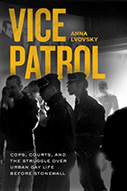Vice Patrol: Cops, Courts, And The Struggle Over Urban Gay Life Before Stonewall

Author: Anna Lvovsky
Publisher: Chicago: University of Chicago Press, 2021. 360p.
Reviewer: Jordan Carr Peterson | August 2021
The lion’s share of legal scholarship on the attainment of political rights and civil liberties for individuals who identify as gay or practice same-sex intimacy tends with reason to focus on developments over the most recent three or four decades. This emphasis coincides with the achievement of several landmark victories for advocates of gay rights and their allies before the United States Supreme Court, including judicial affirmation of the right to civil marriage and the freedom to engage in private, consensual, nonprocreative sexual intercourse. By contrast, in Vice Patrol: Cops, Courts, and the Struggle Over Urban Gay Life Before Stonewall, Anna Lvovsky examines with both precision and breadth a time period during which litigants in queer society encountered considerably greater difficulty in the justice system: the era in which anti-gay vice squads closely regulated the contours of queer life in the United States. This important book casts new light on the legal intricacies and political realities of anti-gay legislation several generations before courts began looking with disfavor on laws stigmatizing or even criminalizing members of the queer community.
Lvovsky’s work contributes to the collective understanding of how American law structured the lives and livelihoods of individuals in queer society in two primary ways. First, she dispels with the notion that there was but one unitary state actor responsible for the formulation and implementation of public policy toward gay people in the middle third of the twentieth century. Rather than providing only an overview of practices by police on the vice beat, Lvovsky instead examines the conduct and revealed preferences of actors across the multiplicity of institutions involved in the administration of laws governing gay life prior to Stonewall. Second, the book situates its exploration of how police departments, administrative agencies, and courts responded to their own responsibilities under the law within a broader analysis of variation in public conceptions regarding what it means to seem, act, or be queer. This allows Lvovsky to contextualize the differential commitments to enforcing anti-gay legislation among various institutional actors by maintaining that public officials’ particular understanding of same-sex intimacy has the capacity to influence their approach to regulatory implementation.
The book examines three categories of anti-gay public policy spanning from the 1930s to the 1960s: liquor boards responsible for licensing and regulating urban nightlife establishments (including and especially gay bars) subsequent to the repeal of prohibition, the enforcement of criminal prohibitions on solicitation of same-sex intimacy via plainclothes police acting as decoys, and crackdowns on sex in public places (and specifically public restrooms) through various forms of police surveillance. This design – capturing the institutional heterogeneity among agencies and offices responsible for implementing anti-gay laws – permits Lvovsky to evaluate how the operation of public policies geared toward curtailing the public expression of gay life varied in efficacy, intensity, and scope. Moreover, within each of the chapters on these three primary areas, she differentiates further between how the classes of public officials charged with implementing these laws – police officers, liquor board agents, prosecutors, and judges – chose to approach that task. Lvovsky also provides a detailed overview of the historical understanding of homosexuality in psychology, and traces the integration of academic psychological understandings of same-sex intimacy into the legal framework governing numerous aspects of queer life.
Lvovsky’s work speaks perhaps most impressively to how the separation of powers in the American policy state can, under the right conditions, serve to frustrate the purposes of certain regulatory regimes. Importantly, Vice Patrol takes care to avoid minimizing or softpedaling the degree to which enforcement of legislation targeting gay life by midcentury police and courts engendered profoundly negative consequences for the many individuals subject to arrest, prosecution, and conviction. Nevertheless, the work complicates the traditional picture of the vice squad in action by using careful archival research to introduce readers to the legal means through which some individuals were able to avoid the most drastic ramifications associated with anti-gay laws.
Most notably, the book argues that there was a nonnegligible degree of hesitance among administrative and (especially) judicial officials concerned by some of the perceived excesses perpetrated by officers on the vice squad, and in particular those involved in plainclothes decoy stings and in close surveillance of public restrooms. While precious few (if any) of the more egregious practices engaged in by the vice squads were ever summarily overturned as a matter of appellate judicial action, many judges demonstrated a willingness to inquire as to the tactics and – though usually implicitly – the motives of arresting officers when overseeing prosecutions of individuals brought in on charges of solicitation or crimes against nature. At the time of the events examined in the book, it would of course be a half century before criminal prohibitions on sodomy were deemed to violate the constitutional guarantee to due process by the Supreme Court. In the absence of such a centralized directive modifying the constitutional parameters of the substantive criminal law, judges in prosecutions based on actions observed by the vice squads were best suited to permit some individuals to evade conviction and punishment through means that did not call into question the permissibility of the underlying criminal prohibitions (or civil regulations, in the case of the liquor boards).
The demand for judicial creativity in blunting the impact of criminal or administrative proceedings stemming from vice squad activity meant that there was considerable variation in the legal mechanisms employed to shield individuals from prosecution or delicensure. While Lvovsky’s primary purposes in Vice Patrol read chiefly to me as social and historical rather than doctrinal in nature, she nevertheless analyzes thoroughly a number of the doctrinal innovations employed by some courts to curb some of the especially problematic actions by the vice squads. For instance, some judges demonstrated considerable frustration with the deceptive and aggressive tactics used by plainclothes police decoys sent into bars, restrooms, and public parks to invite sexual advances from individuals seeking same-sex intimacy with the aim of securing an arrest for solicitation. Likewise, some of the officials responsible for administrative oversight of liquor board delicensing actions expressed skepticism that vice squads, sent into gay bars to ensure that no “known homosexuals” were being served therein, were able to supply sufficient evidence that the bar’s management met the legal standards for the knowledge required of their patrons’ sexual identity by the state liquor boards. Generally speaking, however, judicial management of the ethical standards undergirding vice squad activity tended to be supported not by explicit principles of constitutional law or human rights, but rather by ad hoc declarations by certain judges that imposing criminal sanctions for consensual sexual intimacy was morally unfair.
This limited judicial resistance to the excesses of the vice squads – already incomplete in its scope, and not in any way informed by modern understandings of homosexuality or same-sex intimacy – can be used to illustrate both the promise and the confines of reliance on the judiciary to secure individual rights and liberties. In its most positive light, in addition to the immediate and obvious material benefits for those queer defendants whose lives were not further demeaned if a sympathetic judge managed to circumvent a criminal conviction for solicitation or sodomy, demonstrable skepticism among judges hearing cases in which the state relied on evidence from vice squad activities could have contributed to the wider effort to delegitimize the criminalization of same-sex intimacy. In this sense, and provided we permit a sufficiently broad conception of what qualifies as law, even limited judicial rejection of vice squad prosecutions may have constituted one building block in a larger deregulatory project that changed the collective, constitutive understanding of which sexual practices may be the subject of criminal sanctions by the state.
On the other hand, the separation of powers serves as a significant institutional constraint on the capacity of the judiciary to revise public policy. This is, of course, especially so in the context of decisions reached by trial judges, the primary venue analyzed in Lvovsky’s research, given the narrow precedential scope of judgments rendered by such courts. As a result, even making some optimistic assumptions about the percentage of trial judges at midcentury who opposed trying and convicting individuals for soliciting sex from a vice squad officer (assumptions which, I should note, are not entirely realistic in light of Lvovsky’s archival evidence), judicial suspicion of vice squad activity on its own was insufficient to prevent the continued enforcement of these serious legal constraints on gay life for the better part of the pre-Stonewall era.
Lvovsky’s book should prove of interest for scholars of law, criminal justice, history, and the social sciences alike. Though there are significant limitations detailed in the book in the recordkeeping of proceedings that occurred as a result of vice squad activity, future legal scholars might consider comparing how judicial oversight of vice squad practices compares with other instances in which trial judges develop procedural doctrines in a relatively improvisational manner on the basis of perceived equity. Likewise, researchers in criminal justice and the social sciences, when analyzing how police departments more generally adapt subsequent to negative managerial decisions by the judiciary, might consider Lvovsky’s account of how vice squads altered their standard operating procedures in light of the realization that some of their practices had grown into disfavor with certain judges. Taken as a whole, Vice Patrol offers a revealing perspective on a dark period in queer history, and provides a fuller conception of how the fragmentation of legal authority as a feature of institutional design – in this case, across various institutions responsible for implementing laws dramatically restricting the quality of queer life – has the power to both advance and frustrate the achievement of equitable governance.
Jordan Carr Peterson, Assistant Professor, School of Public and International Affairs, North Carolina State University


